GLBenchmark 2.5 Performance on Modern Android Smartphones & Tablets
by Anand Lal Shimpi & Brian Klug on July 31, 2012 10:00 AM EST- Posted in
- Smartphones
- GLBenchmark
- Mobile
- Tablets
- SoCs
For quite a while now, GLBenchmark has been a regular test in our smartphone, tablet, and SoC reviews. As GPU performance has steadily increased, GLbenchmark 2.1.x started hitting vsync more of the time in onscreen tests, necessitating an updated version of the test with heavier assests, reworked rendering code, and improved functionality for testing. Today Kishonti Informatics has released GLBenchmark 2.5.0 both on the Google Play store and to partners, and we're taking a first look at performance across the current crop of devices.
GLBenchmark 2.5.0 primarily addresses a few shortcomings from the previous version of the Egypt test, primarily by moving to a more challenging version of Egypt. The new game test is named Egypt HD, and moves to a much more complex scene while keeping roughly the same test animation. Geometry count has increased, texture resolution has increased, there's a new water shader, more reflections, and more shadowing. In addition, the offscreen test has now moved to a default resolution of 1080p instead of the previous 720p, for a more challenging workload. This offscreen resolution is now customizable, but we'll be running 1080p for ease of comparison. In addition, the "classic" Egypt test is also a part of GLBenchmark 2.5.0 for those wishing to compare to 2.1.5. In addition, the triangle and fill subtests also stay around for a lower level look at OpenGL ES 2.0 performance. It should go without saying, but GLBenchmark 2.5 is still an OpenGL ES 2.0 test.
We've run GLBenchmark 2.5.0 on all the devices we have on hand, and have split up the results between tablets and smartphones for ease of comparison. The iOS version of GLBenchmark 2.5.0 is still in the review process, and we'll be updating as soon as we can run that on our iPhone 4S, iPad 2, and iPad 3. For now however, we have a good look at performance for the latest devices in Android land.
Tablets
We have three major SoCs making up our tablet test candidates: NVIDIA's Tegra 3, NVIDIA's Tegra 2 and TI's OMAP 4430. When we get the iOS versions of GLBenchmark 2.5 we'll be able to add the A5 and A5X to this list. We're also waiting on our own Qualcomm MDP/T, which will let us add Adreno 320 results in a few weeks.
The fill and triangle rate tests show us just how far we've come since the days when Tegra 2 and the PowerVR SGX 540 were considered cream of the crop. NVIDIA's Tegra 3 is just significantly faster across the board. The Transformer Pad Infinity's added memory bandwidth (DDR3-1600) helps propel it above the other, lesser Tegra 3 configurations. Again there's nothing new here, just new data that validates what we've already known.
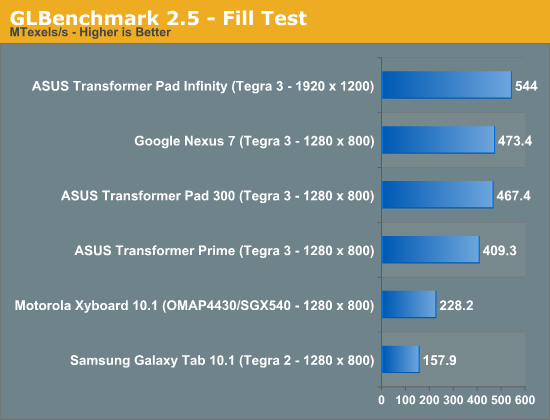
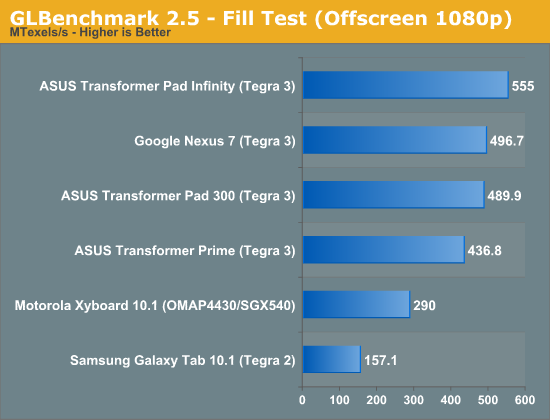
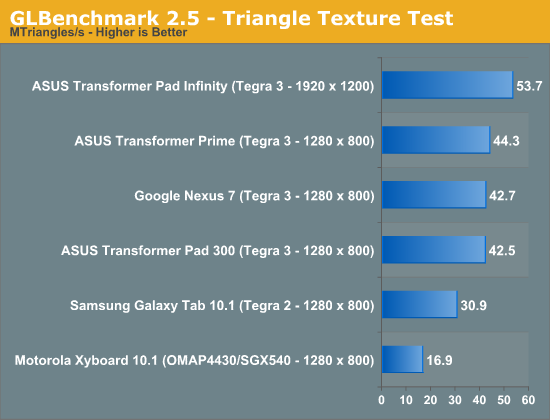
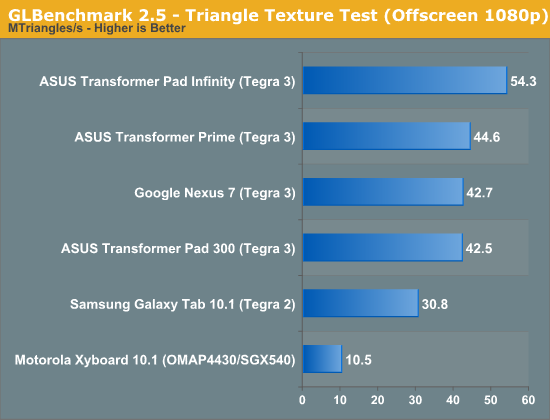
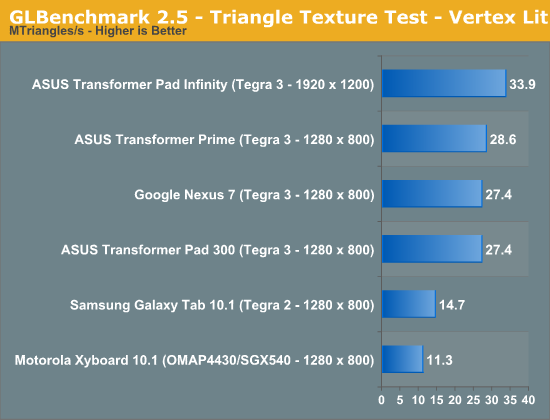

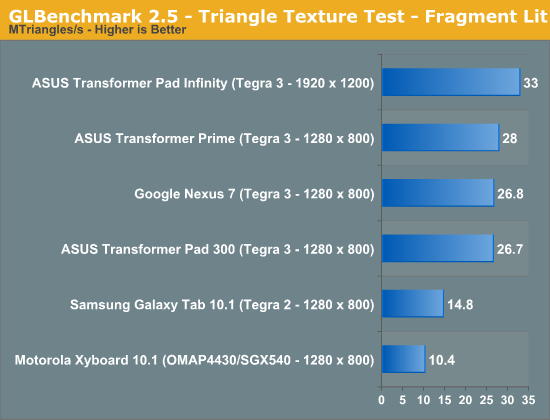
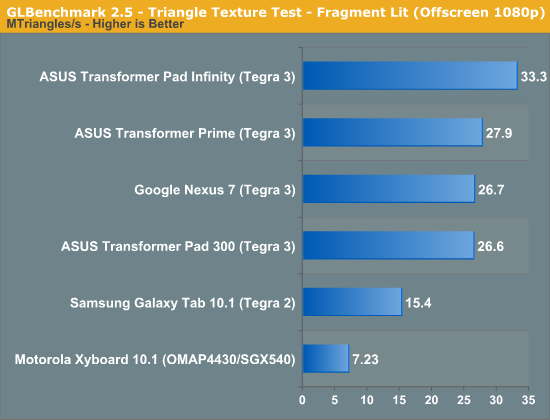
The Egypt HD test raises the bar for what is necessary to produce playable frame rates. At their native resolutions, none of these tablets can even deliver half of a playable 30 fps frame rate. For the next generation of games, we'll need performance around 3x better than NVIDIA's Tegra 3. Qualcomm's Adreno 320 has the ability to deliver that depending on the workload, so it's possible we may see > 30 fps results from it. The A5X should be able to break 30 fps as well, but we'll find out for sure in another day or so.
The offscreen results are even worse. Tegra 3 with DDR3-1600 is still only good for 11 fps. It shouldn't be any surprise, but we will need faster GPUs for better looking games. Egypt HD is definitely the new torture test for mobile SoCs.
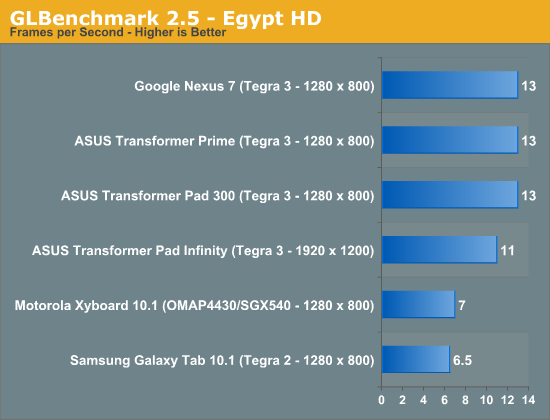
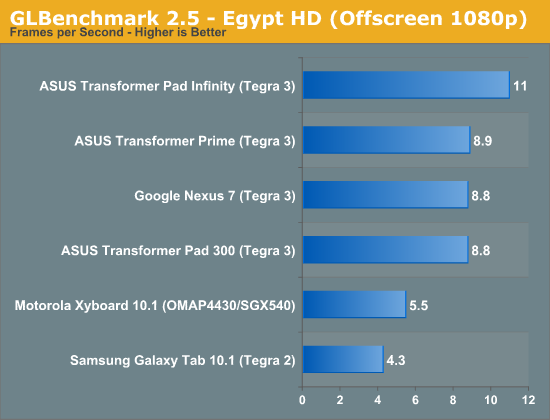
The Egypt Classic test ends up being Vsync limited on the 1280 x 800 Tegra 3 tablets, with even 1920 x 1200 running smoothly on the Transformer Pad Infinity. These numbers echo the reality of 3D gaming on Android today: pretty much everything runs well on Tegra 3.
The same can't be said for Tegra 2 or OMAP 4430 however, even at 1280 x 800 both of these SoCs deliver frame rates well below 30 fps.
The offscreen 1080p results paint a good picture for Tegra 3, which again can deliver average frame rates at or above 30 fps. Anything older than Tegra 3 however just can't pull it off.
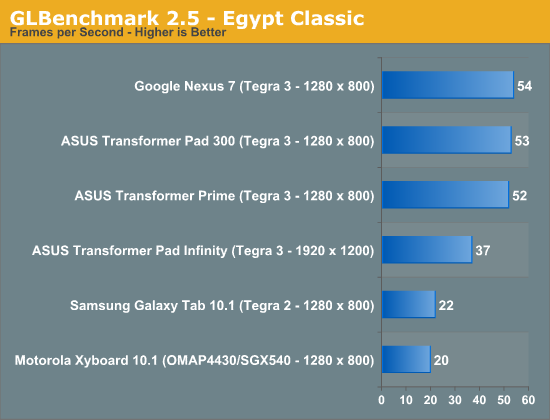
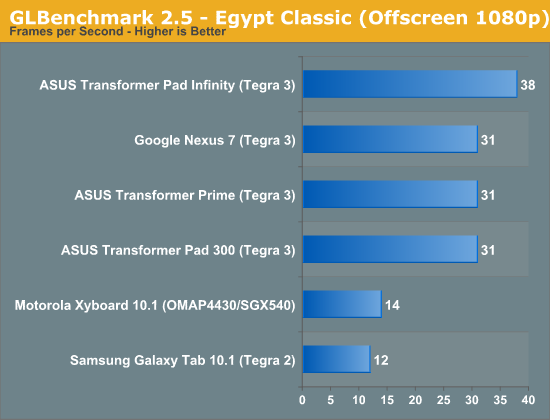

















47 Comments
View All Comments
tipoo - Tuesday, July 31, 2012 - link
I wonder where these would be ranked among old desktop GPUs, Geforce 4 series-ish? FX series?aruisdante - Tuesday, July 31, 2012 - link
They're much more modern than that in terms of features, as they support the roughly mobile equivalent to DX9/OpenGL2.0.The fact that Tegra and Mali have dedicated Pixel and Vertex shades puts them in roughly the GeForce 7 series, although they're probably more powerful clock-per-clock-per-unit than those cores were (not enough to make up the vast difference in clock-speed though). If you just look at raw hardware, it would put them roughly equivalent to somewhere between a 7300GT and a 7600GT. However their raw throughput numbers are a lot lower thanks to the reduced clockspeeds- Even a 7100GS ran at 600+Mhz.
The SGX is a Unified Shader Arch supporting DX10.1 like functionality, putting it in the GeForce8-GTX200 era. What they define as a 'core' is a bit hard to figure out (I would guess they mean SMP, I.E. a cluster of smaller USA Shader Units), but based on the numbers it would be somewhere at the very bottom of the rung, like GeForce 9300 but not even.
tipoo - Tuesday, July 31, 2012 - link
Funny how much more advanced SGX GPUs are than a GPU giant like Nvidias. But that could well change next gen with kepler based Tegras.tuxRoller - Tuesday, July 31, 2012 - link
I believe adreno is also unified since the 200 series.I'd also be astonished if nivida gets anywhere close to the 3.5 years old 543mp let alone any of their newer models. I imagine the problem for nvidia will be getting around all the patents of img.
GraveUypo - Tuesday, September 25, 2012 - link
i know i'm a few months late to the party but...he was almost spot-on as far as raw performance goes on his guess. i'll be honest, i'm not familiar with the performance of the lower end nvidia cards, but a 7600GT is definitively a lot faster than even the ipad 3 gpu.
features aside, if we stick to theoretical peak performance, most current mobile gpus rank in between a geforce 4 ti4600 and a geforce fx. here's a quick comparison of gpu theoretical peak performance:
· Nexus 7 (tegra 3) - 10 Gflops
· Galaxy s3 (mali-400mp) - 15,8 Gflops
· IPad 3 (SGX 543MP4) - 25,6 Gflops
· Geforce 4 Ti4600 - 16 Gflops
· Geforce FX 5950 Ultra - 30,4 Gflops
· Geforce 6800 Ultra - 75 Gflops
· > Geforce 7600 GT - 136 Gflops
· xbox360 and ps3 gpu - somewhere around here, closer to the latter
· Geforce 7950 GT - 255 Gflops
as you can see, there's still a lot of ground to cover to get to 7600GT levels of performance. maybe in a couple more generations. This is a very simplified comparison, because there's no way to compare them directly, but it's enough to give you an idea of the situation.
GraveUypo - Tuesday, September 25, 2012 - link
(a few months later, but here we go)yes. very nice guess.
in fact the theoretical peak performance of the mali-400mp on the galaxy s3 is virtually the same as a geforce4 ti4600. the SGX 543MP4 on the ipad 3 is a bit inferior to the geforce fx 5900 ultra. read my other post for more details :P
UpSpin - Tuesday, July 31, 2012 - link
So Tegra 3 is better and Exynos Quadcore worse than most people think. At least in more demanding games with more polygons.And thus the US Galaxy S3 probably faster in more recent games with more polygons than the international quad core version. (more modern ARM core and faster GPU).
It will be interesting how well the Apple SoCs scale with this HD test.
And even if the results might look poor, but including some older speced SoCs might be interesting, too, to see how the new SoCs improved. Like some older Snapdragons. (and only Offscreen seems to be interesting)
Arnulf - Tuesday, July 31, 2012 - link
WTF are you babbling about, there is no mention of Exynos, let alone quad core Exynos, anywhere in the article. ?!owan - Tuesday, July 31, 2012 - link
Did you even read the second page?owned66 - Tuesday, July 31, 2012 - link
lol epic fail